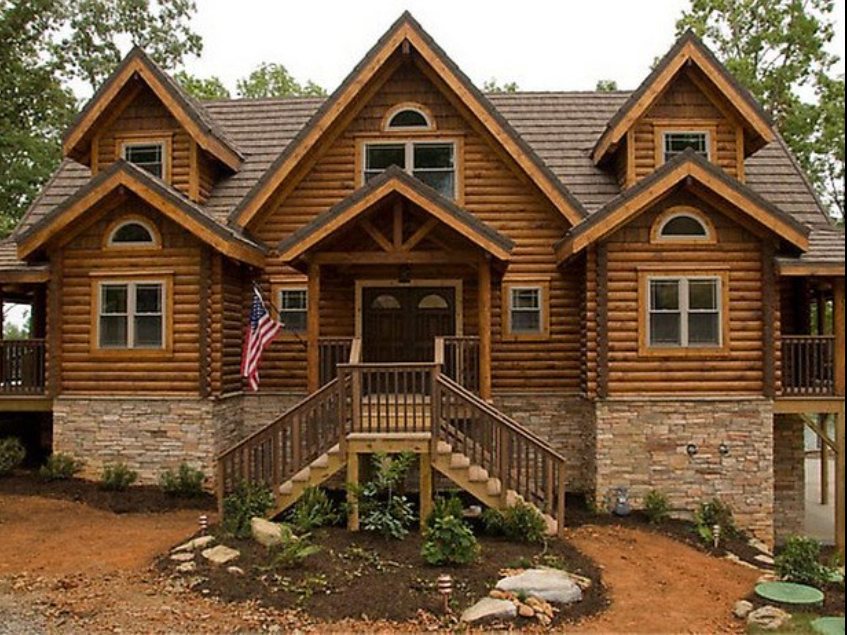
The best exterior stain for log homes are oil or water-based products that saturate wood pores to prevent water penetration, which is of paramount importance in protecting your logs. These stains typically contain a drying oil or resin in a transparent or semitransparent stain. Since wood is a natural material that expands and contracts, you’ll want a stain that won’t crack with the organic movement of your logs.
Using a quality stain, such as the products offered by Sascho, is important to avoid crack as your logs expand with moisture or heat, and contract with cold or dry air.
Water-based latex or acrylic stains and finishes are elastic and flexible, which keeps your layer of stain strong and durable throughout the changing seasons.
Choosing a stain and actually staining are two very different things. Part of the plan must be to sample the stain on the logs so you know what color to expect. Log preparation is key to achieving the color match that you are looking for.
Compatibility
If your home is already stained, stain compatibility is a huge issue because not all stains are compatible with one another or with all sealants. If at all possible, we like to match the current stain and brand you have to minimize color variations. It’s important to select a stain that will be compatible with caulking and chinking as well. Even the simplest of log homes can have thousands of linear feet of log joints, many of which will need to be sealed at some point, adhesion compatibility with the stain you use is critical.
There are different types of stains available to you. Keep in mind that not all stains are created equal, and how deep a stain penetrates doesn’t necessarily equate to better performance. The best value for your dollar may be in a more expensive stain that has been formulated for a specific type of application, i.e. decks, logs, wood siding, etc. With all types, good prep is important to get maximum longevity.
Surface Stains:
Are durable, water based, easy to clean, low odor, resin is UV resistant, and easier maintenance. However, they do occasionally crack & peel, and lap marks can occasionally be a challenge. Proper application is key.
Acrylic Water-based Stains:
This type of stain is flexible, long lasting, permeable to moisture vapor, easy to clean, stain protection, bright pigmentation and comes in a variety of colors.
Shallow oil-based stains:
This stain will provide beauty, good penetration into the wood fibers, is easy to recoat with compatibility. It doesn’t always have the longevity as other types and can become brittle with age and show slight erosion and peeling.
Deep penetrating stains:
We like this stain for its easy application, no lap marks, easy maintenance, ½” deep into the wood fibers. Great for DECKS! However, not always the best fit as Chinking/Caulking has a harder time sticking, there can be adhesion loss, color transfer isn’t always perfect, and frequent application is often required as the “nondrying oils” penetrate deeper and deeper into the fiber, thus leaving the outer wood fibers exposed to the elements.
Choosing a Stain Color
Your stain color sets the tone of your home—which is why it’s important to request samples and test several different stains and colors to ensure you get the color you want. It is recommended to stay away from clear coat stains for their lack of UV protection. A clear coat that promises to preserve the “just built” look is misleading. It’s impossible to load enough UV absorbers in any clear stain to sufficiently protect your wood.
Those who have already tried a clear finish are reporting they have to keep re-applying a finish every year or two. The cost and time are tremendous. The clear finishes alone offer very little protection from the sun’s ultra-violet rays. If you ever noticed alongside the road a tree without bark, it turns gray from the sun, absorbs moisture from rain, and eventually the insects will infest the wood as rot takes place, returning the wood back to Mother Nature in the form of fertilizer.
Pigmented stains offer you protection from the harmful UV rays that break down your finish. They will absorb the UV rays and deflect them. Usually, the top portion of your logs receive the most sunlight. Sun, moisture, and insects are the biggest hazards to your log home. Protecting your logs with a quality, pigment stain will have the greatest impact on the preservation of your logs.
Maintenance
Routine maintenance is necessary, but the lifespan of a finish depends on a variety of factors. Construction details, exposure to the elements, product choice, surface preparation, and application techniques are all essential to success. Some finishes may even require chemical stripping or sandblasting to restore wood to the proper condition before re-treatment. Finishes that weather unevenly and are re-coated without removing the old finish will have an unsightly patchy appearance. Be sure to do your research if you intend to tackle a re-stain on your own. The team at 888 Log Guys are here to help you if you decide it’s time to call in the experts.








